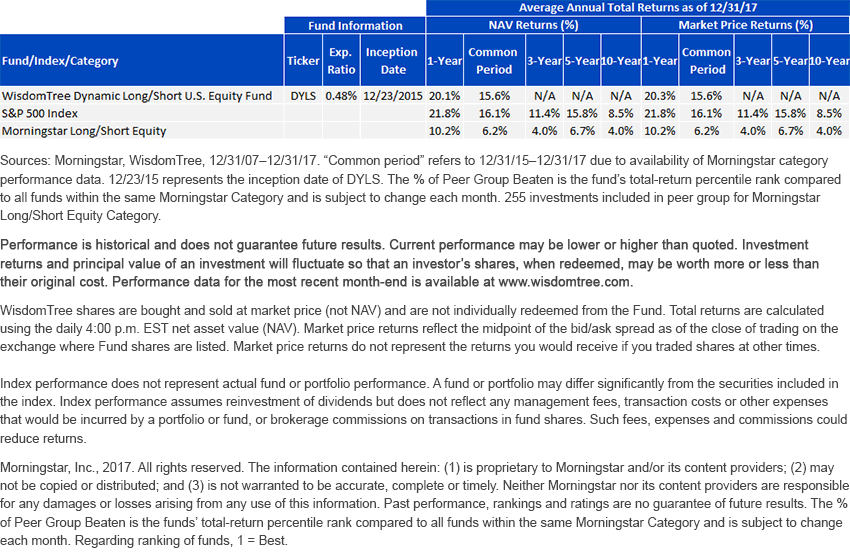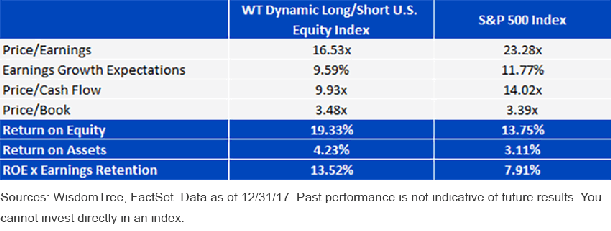An Alternative Approach to Lower-Volatility Indexing Strategies


In December, we passed the two-year anniversary of the WisdomTree Dynamic Long/Short U.S. Equity Fund (DYLS)—an interesting alternative strategy WisdomTree launched at the end of 2015. The market environment over the last two years was a struggle for any funds that incorporated bearish bets, as the market has been robust over the last few years.
With anxieties over market valuations, the “quantitative tightening” program underway by the Federal Reserve (Fed) to remove their emergency accommodation, and the past several days of heightened volatility, it seems useful to evaluate strategies that have a goal of reducing volatility in the marketplace.
Even my mentor, Professor Jeremy Siegel, one of the more bullish market prognosticators, has been generally more cautious of late with subdued expectations, thinking the market will pause and we’ll get a correction later this year.
WisdomTree established DYLS to incorporate a dynamic hedge of market beta that would react to changes in valuations and underlying earnings quality and earnings momentum. During robust earnings environments, like we’ve seen for much of the last two years, the hedge ratio remains at zero and the Fund remains fully invested.
DYLS will not always be fully invested and hasn’t been in real time either: There was a period after the Fund launched in late 2015 and in early 2016 when it was fully hedged and protected from the market sell-off that occurred in the first two months of 2016, until the hedge came off March 2 and DYLS participated in the upturn for the rest of 2016.
When we evaluate the performance of DYLS versus its peer group, we can see a fairly robust track record. It has beaten 100% of its active manager peers and the Morningstar peer group return by more than 20% cumulatively since its inception.


One of the benefits of utilizing DYLS in an ETF format is that the portfolio exposures are readily observable and underlying risks are known. There are two drivers of this ETF:
- The Long Portfolio: The long portfolio strategy is designed to have a lower market multiple (whether on price-to-earnings or price-to-cash flow variables) than the market while also improving quality variables such as return on equity or return on assets.
- The Short Portfolio: The short portfolio strategy hedges market risk based on a proprietary risk indicator that incorporates valuation and earnings momentum signals.
We have also considered DYLS to be an alternative to other lower-volatility strategies, including the minimum variance indexes that lower portfolio volatility by taking stock selection and sector risks.
One risk to a traditional minimum variance indexing strategy is an embedded interest rate sensitivity that is inherent to many low-volatility stocks. With interest rates starting to be pressured higher with the quantitative tightening program of the Fed and expanding federal deficits, higher rate sensitivity could be a drag for traditional low-volatility stock strategies, especially since we see these stocks trading at a premium multiple to the market instead of a discount to the market, like the WisdomTree Dynamic Long/Short U.S. Equity Index.

We’ve seen the WisdomTree Dynamic Long/Short U.S. Equity Index have a similar up capture ratio as the minimum variance index, while having a lower net beta over the last two years.

For definitions of terms in the chart, please visit our glossary.
Add to this what we see as a better combination of current fundamentals—lower market multiples and sector neutrality, which lowers an inherent interest rate factor sensitivity—and we see the WisdomTree Dynamic Long/Short U.S. Equity Fund, the fund that tracks the WisdomTree Dynamic Long/Short U.S. Equity Index, potentially being a compelling alternative to other volatility-reducing strategies investors have considered recently.
Important Risks Related to this Article
There are risks associated with investing, including possible loss of principal. The Fund will invest in derivatives, including as a substitute to gain short exposure to equity securities. Derivative investments can be volatile, and these investments may be less liquid than other securities, and more sensitive to the effects of varied economic conditions. Derivatives used by the Fund to offset its exposure to market volatility may not perform as intended. The Fund may engage in “short sale” transactions and will lose value if the security or instrument that is the subject of a short sale increases in value. A Fund that has exposure to one or more sectors may increase the Fund’s vulnerability to any single economic or regulatory development. This may result in greater share price volatility. The composition of the Index is heavily dependent on quantitative models and data from one or more third parties, and the Index may not perform as intended. The Fund invests in the securities included in, or representative of, its Index regardless of their investment merit, and the Fund does not attempt to outperform its Index or take defensive positions in declining markets. Please read the Fund’s prospectus for specific details regarding the Fund’s risk profile.

Jeremy Schwartz has served as our Global Chief Investment Officer since November 2021 and leads WisdomTree’s investment strategy team in the construction of WisdomTree’s equity Indexes, quantitative active strategies and multi-asset Model Portfolios. Jeremy joined WisdomTree in May 2005 as a Senior Analyst, adding Deputy Director of Research to his responsibilities in February 2007. He served as Director of Research from October 2008 to October 2018 and as Global Head of Research from November 2018 to November 2021. Before joining WisdomTree, he was a head research assistant for Professor Jeremy Siegel and, in 2022, became his co-author on the sixth edition of the book Stocks for the Long Run. Jeremy is also co-author of the Financial Analysts Journal paper “What Happened to the Original Stocks in the S&P 500?” He received his B.S. in economics from The Wharton School of the University of Pennsylvania and hosts the Wharton Business Radio program Behind the Markets on SiriusXM 132. Jeremy is a member of the CFA Society of Philadelphia.

